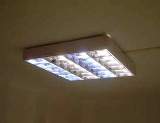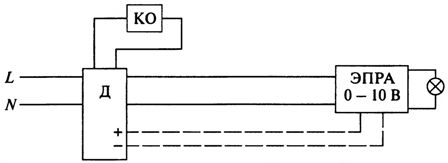Analog lighting control
 For analog lighting control, in addition to the illuminator itself, two more controls are needed: the command (hereinafter KO) — the one that sends a command to change the operating mode of the lighting installation (OU), and the executive (hereinafter IO) — one that directly changes the mode of operation of the lighting installation.
For analog lighting control, in addition to the illuminator itself, two more controls are needed: the command (hereinafter KO) — the one that sends a command to change the operating mode of the lighting installation (OU), and the executive (hereinafter IO) — one that directly changes the mode of operation of the lighting installation.
Traditionally KOs are: presence / motion sensors, buttons and remote switches and level controls, timers, light sensors. In the role of IO — twilight switches, impulse relays, mini-contactors, light intensity regulators (further dimmers).
Sometimes the functions of KO and OI are combined in one device, an example is a dimmer with a built-in dimmer.
The brightness level of 12V incandescent halogen lamps is usually controlled by simply changing the voltage level applied to the terminals of the dimmer fixture.
Currently, electronic ballasts for discharge lamps and electronic transformers for 12 V halogen lamps are widely used. In technical practice, these devices use the general name "ballast".Controlling lighting fixtures with electronic ballasts by simply changing the supply voltage level is impossible in the case of discharge lamps and undesirable in the case of 12 V halogen lamps with filament (GLN). Therefore, the so-called «0 — 10 V» dimming protocol in this case.
The 0-10V ballast is still fed through the dimmer, but in addition to it, an extra pair of control wires is connected to the dimmer. The control of the level of illumination in the range 100 - 5% is carried out by the ballast itself according to the signal from the dimmer, and the dimmer itself turns off the power supply only when there is a corresponding signal from KO.
A schematic diagram of lighting control by analog method is shown in fig. 1.
Rice. 1. Control circuit of the lighting fixture according to the analog scheme
An additional effect of using the 0-10 V protocol is the removal of the heat parts of the regulators outside the place of installation of the dimmer and their dispersion.
Ancharova T.V. Lighting networks of industrial buildings.

